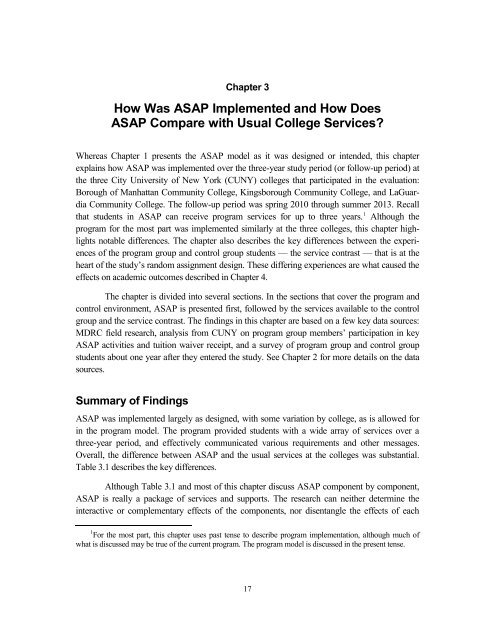1dOprzL
1dOprzL
1dOprzL
You also want an ePaper? Increase the reach of your titles
YUMPU automatically turns print PDFs into web optimized ePapers that Google loves.
Chapter 3How Was ASAP Implemented and How DoesASAP Compare with Usual College Services?Whereas Chapter 1 presents the ASAP model as it was designed or intended, this chapterexplains how ASAP was implemented over the three-year study period (or follow-up period) atthe three City University of New York (CUNY) colleges that participated in the evaluation:Borough of Manhattan Community College, Kingsborough Community College, and LaGuardiaCommunity College. The follow-up period was spring 2010 through summer 2013. Recallthat students in ASAP can receive program services for up to three years. 1 Although theprogram for the most part was implemented similarly at the three colleges, this chapter highlightsnotable differences. The chapter also describes the key differences between the experiencesof the program group and control group students — the service contrast — that is at theheart of the study’s random assignment design. These differing experiences are what caused theeffects on academic outcomes described in Chapter 4.The chapter is divided into several sections. In the sections that cover the program andcontrol environment, ASAP is presented first, followed by the services available to the controlgroup and the service contrast. The findings in this chapter are based on a few key data sources:MDRC field research, analysis from CUNY on program group members’ participation in keyASAP activities and tuition waiver receipt, and a survey of program group and control groupstudents about one year after they entered the study. See Chapter 2 for more details on the datasources.Summary of FindingsASAP was implemented largely as designed, with some variation by college, as is allowed forin the program model. The program provided students with a wide array of services over athree-year period, and effectively communicated various requirements and other messages.Overall, the difference between ASAP and the usual services at the colleges was substantial.Table 3.1 describes the key differences.Although Table 3.1 and most of this chapter discuss ASAP component by component,ASAP is really a package of services and supports. The research can neither determine theinteractive or complementary effects of the components, nor disentangle the effects of each1 For the most part, this chapter uses past tense to describe program implementation, although much ofwhat is discussed may be true of the current program. The program model is discussed in the present tense.17


